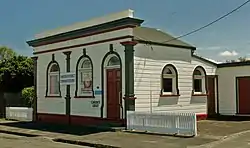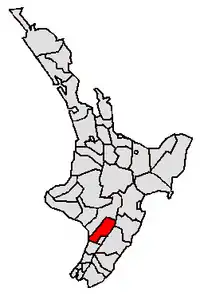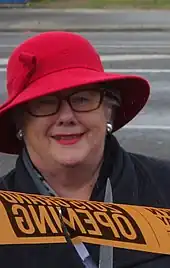Manawatū District
Manawatū District is a territorial authority district in the Manawatū-Whanganui local government region in the North Island of New Zealand, administered by Manawatū District Council. It includes most of the area between the Manawatū River in the south and the Rangitīkei River in the north, stretching from slightly south of the settlement of Himatangi in the south, to just south of Mangaweka in the north, and from the Rangitīkei River to the top of the Ruahine Range in the east. It does not include the Foxton area and the mouth of the Manawatū River, or Palmerston North City (which includes Ashhurst). Its main town is Feilding. The district has an area of 2,624 km².
Manawatū District | |
|---|---|
 Rongotea Community Centre and Library (2011) | |
 | |
| Coordinates: 40°05′35″S 175°46′55″E | |
| Country | New Zealand |
| Region | Manawatū-Whanganui |
| Wards | Feilding Rural |
| Seat | Feilding |
| Government | |
| • Mayor | Helen Worboys |
| • Deputy Mayor | Michael Ford |
| • Territorial authority | Manawatū District Council |
| Area | |
| • Land | 2,566.59 km2 (990.97 sq mi) |
| Population (June 2023)[2] | |
| • Total | 33,900 |
| Time zone | UTC+12 (NZST) |
| • Summer (DST) | UTC+13 (NZDT) |
| Website | www |
Name and geography
Manawatū is said to have been named by Hau, a great Māori explorer. As he pursued his wife, who had left him for another lover, along the south-west coast of the North Island, he came across and named river mouths, including Whanganui, Whangaehu and Rangitīkei according to events that befell him at the time. He then came across the mouth of the large, wide Manawatū River; awed by the sight and in fear he might not be able to cross it, he said, "Ka tū taku manawa" (My heart stands still).[3]
The name Manawatū (often the Manawatu) also refers to the whole area centred on the Manawatū Plains, the floodplain of the Manawatū River, with Palmerston North as its principal city. Like some other areas of New Zealand such as Wairarapa and the King Country, the Manawatū in this sense has never had precisely defined boundaries, its extents determined largely by custom and preference. Always included are Palmerston North and all of today's Manawatū District, and usually included is that part of Horowhenua District lying north of Levin. Parts of Rangitikei and/or Tararua districts might also be included.
Demographics
Manawatū District covers 2,566.59 km2 (990.97 sq mi)[1] and had an estimated population of 33,900 as of June 2023,[2] with a density of 13.2 people per km2. Feilding, the council seat, has a population of 17,750, the only town with more than 1,000. Other towns and settlements include Halcombe, Himatangi Beach, Kimbolton, Pohangina, Rongotea, Sanson, and Tangimoana.
| Year | Pop. | ±% p.a. |
|---|---|---|
| 2006 | 26,070 | — |
| 2013 | 27,459 | +0.74% |
| 2018 | 30,165 | +1.90% |
| Source: [4] | ||
Manawatū District had a population of 30,165 at the 2018 New Zealand census, an increase of 2,706 people (9.9%) since the 2013 census, and an increase of 4,095 people (15.7%) since the 2006 census. There were 11,193 households, comprising 14,943 males and 15,222 females, giving a sex ratio of 0.98 males per female. The median age was 41.3 years (compared with 37.4 years nationally), with 6,282 people (20.8%) aged under 15 years, 5,004 (16.6%) aged 15 to 29, 13,473 (44.7%) aged 30 to 64, and 5,406 (17.9%) aged 65 or older.
Ethnicities were 89.2% European/Pākehā, 16.5% Māori, 2.0% Pacific peoples, 2.6% Asian, and 2.0% other ethnicities. People may identify with more than one ethnicity.
The percentage of people born overseas was 10.6, compared with 27.1% nationally.
Although some people chose not to answer the census's question about religious affiliation, 52.4% had no religion, 35.4% were Christian, 1.1% had Māori religious beliefs, 0.4% were Hindu, 0.2% were Muslim, 0.3% were Buddhist and 1.6% had other religions.
Of those at least 15 years old, 3,657 (15.3%) people had a bachelor's or higher degree, and 5,595 (23.4%) people had no formal qualifications. The median income was $32,400, compared with $31,800 nationally. 3,549 people (14.9%) earned over $70,000 compared to 17.2% nationally. The employment status of those at least 15 was that 12,321 (51.6%) people were employed full-time, 3,498 (14.6%) were part-time, and 726 (3.0%) were unemployed.[4]
| Name | Area (km2) | Population | Density (per km2) | Households | Median age | Median income |
|---|---|---|---|---|---|---|
| Northern Manawatu Rural Ward[lower-alpha 1] | 1,904.36 | 6,588 | 3.46 | 2,337 | 42.7 years | $36,900[5] |
| Southern Manawatu Rural Ward[lower-alpha 1] | 638.59 | 7,779 | 12.18 | 2,871 | 41.1 years | $36,500[6] |
| Feilding Ward[lower-alpha 2] | 23.79 | 15,798 | 664.06 | 5,985 | 40.8 years | $28,900[7] |
| New Zealand | 37.4 years | $31,800 |
- Now combined into a single Rural Ward
- Since slightly enlarged
Local government
.JPG.webp)
Manawatu County Council
Manawatu County Council was one of 63 county councils that were formed in 1876 when the provinces were abolished. It originally extended from Rangiwahia in the north to Waikanae in the south. Over the 12 years to 1888, The towns of Palmerston North, Feilding and Foxton split off to form borough councils. The northern half of Manawatu County split off to form Oroua County Council in 1883. The area south of the Manawatū River split off to form Horowhenua County Council in 1884.[8]
Manawatū District Council
Manawatu District Council was formed in 1988 when Manawatu County Council amalgamated with Kairanga County Council, itself a splinter of Oroua County Council. The following year, Manawatu District amalgamated with Feilding Borough, Kiwitea County, Oroua County and Pohangina County[8] in the 1989 local government reforms.
For the purposes of representation, Manawatū District is divided into two wards:
| Ward name | Number of councillors | Area included |
|---|---|---|
| Feilding | 4 | Feilding (urban) |
| Rural | 5 |

In 2021, the council decided to establish a Māori ward from the 2022 local election.[9]
The council is responsible for day-to-day administration and services:
- Animal control
- Bylaws
- Cemeteries
- Community grants and funding
- Infrastructure such as roads, drains, rubbish collection
- Library services
- Liquor licensing
- Property profiling
Ian McKelvie was elected mayor in a by-election in November 2002 and remained in the position until he resigned on 15 December 2011, after being elected to Parliament in the 2011 election.[10][11] Deputy Mayor Matt Bell was then acting mayor until a by-election held on 7 March 2012.[11] The by-election was narrowly won by Margaret Kouvelis from Feilding, who beat councillor Steven Gibson by just 14 votes (3293 votes to 3279).[12] Helen Worboys won the mayoralty from the incumbent Margaret Kouvelis in the 2016 Local Government elections.
Horizons Regional Council
Manawatū District is in the Manawatū-Whanganui Region, which is governed by the Horizons Regional Council. For electoral and representation purposes, the district is divided into:
- Horowhenua-Kairanga Ward: rural area south of Feilding, including the entire Horowhenua District.
- Manawatū-Rangitikei Ward: Feilding and rural area to the north, and including the entire Rangitikei District.
Tourism

The Manawatū district includes both plains and hills, and is visited by cyclists and others for the views of the Central North Island volcanoes on clear days. The western coast has swimming beaches and large dunes, while the Ruahine Ranges in the east has walking tracks and views over the district from the Wharite mountain or from the Saddle Road.
In the middle of the district is Feilding, with its saleyards, equestrian and motorsport venue (Manfeild), boutique shopping and historical landmarks and collections.
The Royal New Zealand Air Force's main base, RNZAF Base Ohakea, is in Manawatū.
Schools
Secondary:
- Feilding High School, Feilding
- Hato Paora College, Cheltenham
References
- "ArcGIS Web Application". statsnz.maps.arcgis.com. Retrieved 6 March 2022.
- "Subnational population estimates (RC, SA2), by age and sex, at 30 June 1996-2023 (2023 boundaries)". Statistics New Zealand. Retrieved 25 October 2023. (regional councils); "Subnational population estimates (TA, SA2), by age and sex, at 30 June 1996-2023 (2023 boundaries)". Statistics New Zealand. Retrieved 25 October 2023. (territorial authorities); "Subnational population estimates (urban rural), by age and sex, at 30 June 1996-2023 (2023 boundaries)". Statistics New Zealand. Retrieved 25 October 2023. (urban areas)
- "Manawatu". Archived from the original on 9 November 2012. Retrieved 12 November 2012.
- "Statistical area 1 dataset for 2018 Census". Statistics New Zealand. March 2020. Manawatu District (039). 2018 Census place summary: Manawatū District
- 2018 Census place summary: Northern Manawatu Rural Ward
- 2018 Census place summary: Southern Manawatu Rural Ward
- 2018 Census place summary: Feilding Ward
- "History". Manawatū District Council. Retrieved 15 August 2022.
- "Māori Ward". Manawatū District Council. Retrieved 6 March 2022.
- "National Selects Ian Mckelvie As Rangitikei Candidate" (Press release). Voxy.co.nz. 30 May 2011. Retrieved 21 February 2013.
- "Mayor's busy final week" (Press release). Manawatu District Council. 14 December 2011. Retrieved 21 February 2013.
- Crosbie, Sandra (15 March 2012). "Mayor Kouvelis takes the reins". Manawatu Standard. Retrieved 21 February 2013.
Further reading
- Davies, D. A. & Clevely, R. E. (1981) Pioneering to prosperity 1874–1974: a centennial history of the Manchester Block. Feilding: Fisher Printing.
- Holcroft, M. H. (1977) The line of the road: a history of Manawatu County, 1876–1976. Palmerston North: Manawatu County Council.
- Knight, Catherine (2014) Ravaged Beauty: An Environmental History of the Manawatu. Auckland: Dunmore Press. ISBN 978-1-927212-13-4
External links
- Manawatū District Council
- History, Manawatū District Council
- Manawatū and Horowhenua, Te Ara – the Encyclopedia of New Zealand
- Manawatu & City Business Directory